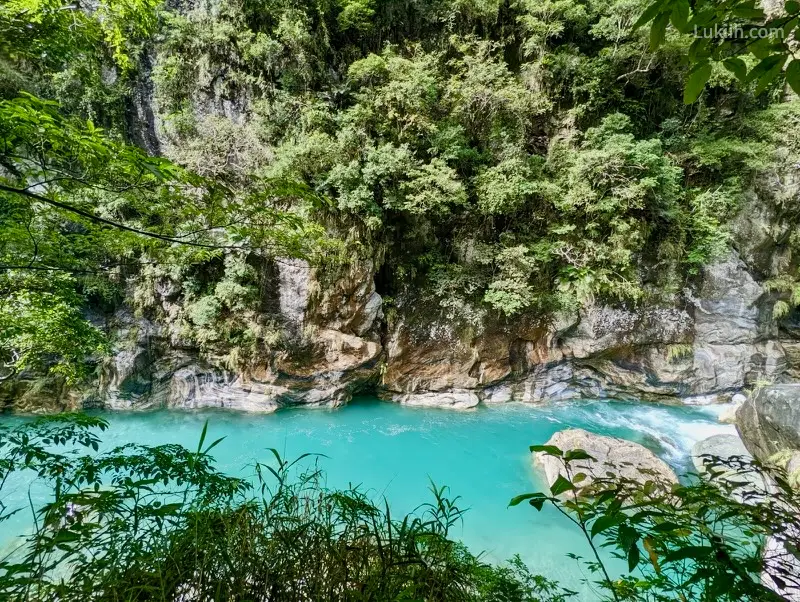Taroko Gorge, the landmark of Taroko National Park, is one of Taiwan’s most famous natural attractions. Here’s my honest review and firsthand tips.
After Taiwan’s April 2024 earthquake, Taroko Gorge is closed and tours are not running at the moment.
Lists By Lukiih is readers-supported. When you buy with my affiliate link, I may earn a small commission. Thanks!
🍀 Lukiih’s Verdict
I highly recommend visiting Taroko National Park if you spend more than three days in Taipei.
- The park features stunning natural beauty and was one of the highlights of my trip.
- Visiting the park from Taipei is moderately priced and includes transportation and a tour guide.
- Minimal preparation is required, as you need to figure out transportation and prepare for a long but straightforward train ride to reach it.

Planning a trip? Here’s what to know about Taiwan.
🏆 Where Does It Rank?
Visiting Taroko Gorge ranks as my #4 thing to do in Taiwan. Here’s how it compares to other experiences on my trip:
My Taiwan itinerary features the above experiences.
✈️ About My Trip
For context on my review, here’s what to know about my trip:
- I finance my trips and don’t receive sponsorship; this review reflects my honest opinions.
- This post has updated 2024 information, but I visited Taroko National Park in 2022.
- My Taiwan trip was in November when it was more crowded and expensive.
🦄 Uniqueness: Average
The Uniqueness Score is based on how rare and memorable an experience is.
Rarity: Uncommon
Visiting Taroko Gorge is an uncommon experience – I estimate fewer than 20 gorges with similar features exist worldwide.
- The gorge is made primarily of marble, giving it a distinct coloration and smooth texture.
- It’s one of the few gorges in the world with a shrine and a river with turquoise water.
- A few comparable gorges exist around the world, including Takachiho Gorge in Japan and Tiger Leaping Gorge in China.
- There are many other stunning gorges with different characteristics worldwide, including the Grand Canyon in the US and the Verdon Gorge in France.
Memorability: Moderate
Visiting Taroko National Park is one of my many memorable experiences in Taiwan.
- The Liwu River, which runs through the gorge, has a striking, unforgettable turquoise color.
- The park has several unique attractions.
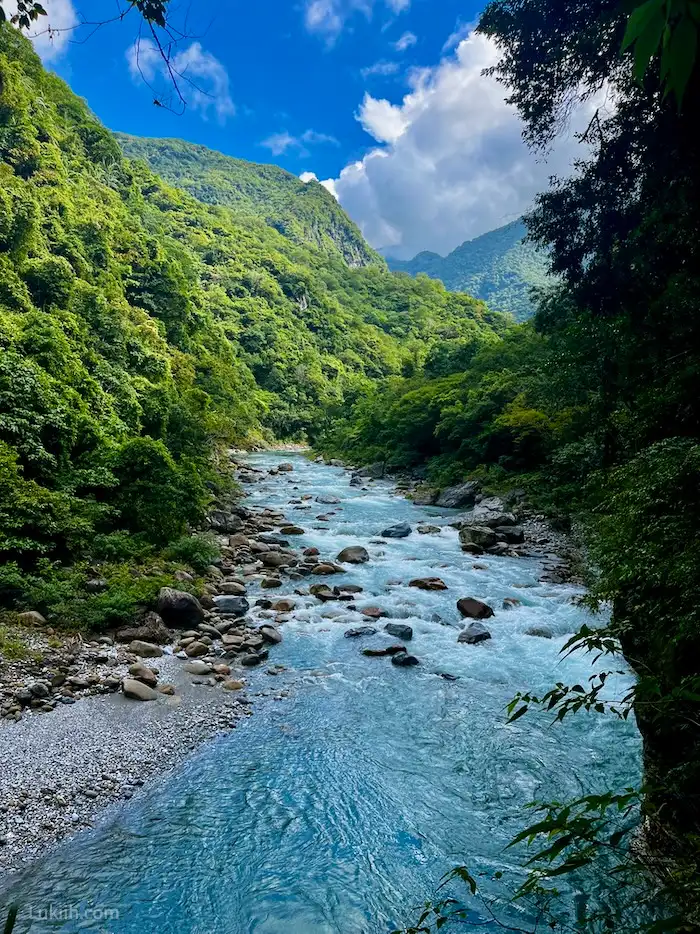
- The park’s attractions collectively make the visit memorable, but the individual attractions are not epic on their own.
😊 Enjoyment: High
The Enjoyment Score is based on how much happiness and reward an experience provides.
Happiness: High
I found visiting Taroko National Park very fun and delightful.
- The park is 26 miles wide and has over a dozen attractions. The varied attractions make exploring them easy to spend an entire day or more.
- A knowledgeable and enthusiastic tour guide like mine increases appreciation for the park as they share fun facts and history that visitors otherwise wouldn’t know.
You can spend a full day visiting its top attractions or stay for two to three days to explore the park deeply and hike its numerous trails. I stayed overnight.
- The park is a popular tourist attraction, so it gets incredibly crowded. For example, the Shakadang Trail often experiences bottlenecks during the peak season.
Reward: Moderate
Visiting Taroko Gorge is a somewhat rewarding experience.
- The park has a decent amount of walking if you want to see attractions thoroughly (e.g., you have to walk to reach the Eternal Spring Shrine or see the other end of Bulowan Bridge).
- You’ll learn a lot about the park’s and Taiwan’s history with a knowledgeable guide.
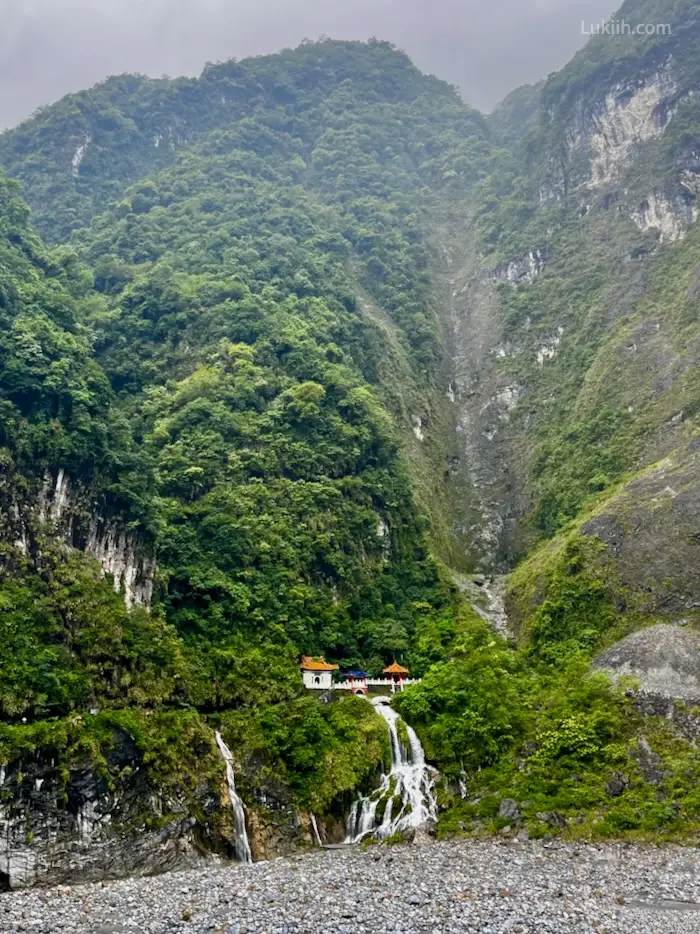
- A mountain highway runs through the park, which makes every attraction accessible by vehicle. You can see the start of many attractions without having to go very far.
💰 Value: Moderate
The Value Score is determined by the price divided by the duration of an experience. All prices mentioned here are in USD.
Price: $100 PP
A day trip to Taroko Gorge costs between $90 and $150, depending on how you get there and what type of tour you book. This extremely well-rated Taroko Gorge guided tour costs $150 (I last checked prices in May 2024).
At about $100 per person for a full-day trip, I consider the experience moderately priced.
Taroko National Park has no entrance fee.
Lukiih Paid: $93
I booked my tour with Island Life Taiwan and paid $93. I highly recommend my tour guide, Iris, who was energetic, entertaining, and knowledgeable (e.g., she knew a lot about the park’s history and the best way to avoid crowds and road closures).

See my Taiwan trip expenses.
🎒 Preparation: Minimal
The Preparation Score is based on the required skills & fitness, transportation, and bookings & packing. The higher the score, the less preparation is needed.
Skills & Fitness: None
You generally don’t need any skills or fitness to visit Taroko Gorge. The only exception is if you want to hike Zhuilu Old Trail, a narrow trail with limited edge protection.
Transportation: Significant
Taroko National Park is located in Hualien County on the eastern side of Taiwan.
- There are several ways to get there from Taipei, including public transportation and car.
- Depending on your transportation method and time of departure, it takes 2.5 to 3 hours to get to the park from Taipei.
Booking & Packing: Minimal
To visit Taroko Gorge, you’ll need minimal booking and packing:
- Hire a guide in advance or figure out how to get to the park by buying train tickets at least one to two weeks ahead.
- Book accommodations if you plan to spend a night in Hualien like I did.
- Wear appropriate clothes and shoes for exploring the park.
If you’re coming from Taipei, I recommend staying in Hualien City for a night because it’s a long journey. You’ll also get to explore the massive Hualien night market.
How To Guide & Tips
Interested in visiting Taroko Gorge after reading my review? Below are practical firsthand tips.
How To Get There
From Taipei, you can get to Taroko Gorge in two ways:
| Transportation | Journey Duration | Total Cost |
|---|---|---|
| 🚐 Organized tour | 3 hours | $100+ |
| 🚆 Train | 3+ hours | $10-$15 |
🚐 Organized Tour
The easiest way to reach the park is by booking an organized tour with a local guide, which will include round-trip transportation. Tour groups will provide a private vehicle to drive you or take care of train tickets on your behalf.
🚆 Train
If you rather take public transportation, you have two train options to get from Taipei to Hualien Station:
- Express trains will take you to Hualien City in under three hours. The fastest trains are the Taroko Express and Puyuma Express, which cost 440 NT (about $14) per trip.
- Local trains will take three to four hours.
You can see all train schedules on Taiwan Railway’s website.
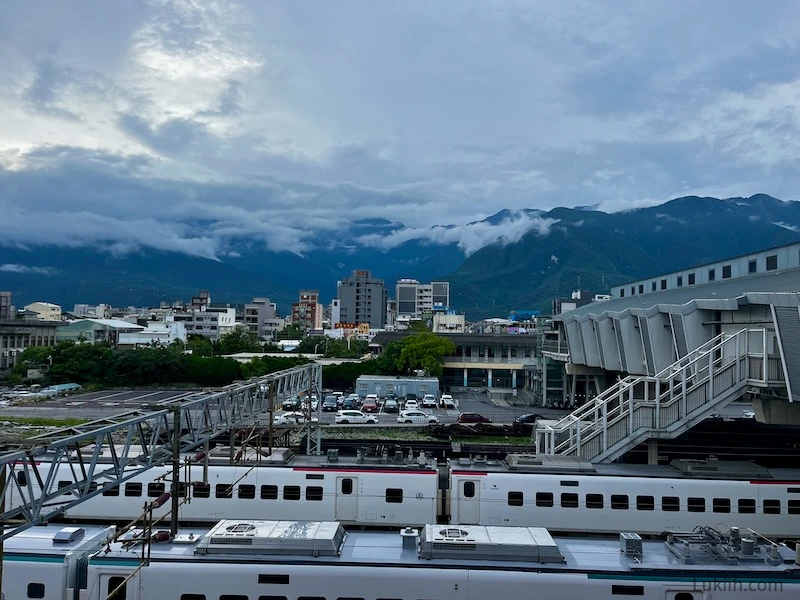
You can purchase a train ticket online or in person:
- Online – The most convenient way to get a train ticket online is through the TRA mobile app (iOS, Android) since the website is confusing and doesn’t let you claim the ticket.
- You must claim your ticket – Booking a train ticket reserves it. If you don’t claim it (in person or digitally) within 20 minutes of departure time, they can release your ticket to another passenger.
- Turn on “English mode” on the TRA app – Once you overcome the minor annoyance of figuring out how to do this, booking and claiming your ticket on the app is easy.
- Each rider needs to claim their own ticket – One rider cannot claim multiple tickets. This means that each rider will have to download the app separately.
- In Person – You can purchase a train ticket in person if you don’t want to deal with the potentially confusing mobile app. Some Hualien train times are very popular and must be booked in advance. Some afternoon departures were already sold out when I booked a train to Hualien a week in advance.
Most trains will depart from the Taipei Main Station. Google Maps has several “Taipei Main Stations,” depending on whether you’re catching a train, bus, or the MRT. Double-check the “Subway services” section of the location on Google Maps to make sure it is the right place.
How To Get Around
Once in Hualien’s city center, Taroko Gorge’s entrance is about a 30-minute drive away. You can explore the park in five ways.
A mountain highway runs east-west across the park, and every attraction is located near the highway, sometimes on the side of the road.
- 🚗 Car or motorbike rental – You can rent a car to navigate the park on your own, but you must have an International Driver’s Permit (IDP) to drive in Taiwan legally.
Note that many attractions do not have sufficient parking when they get crowded (I experienced this firsthand).
- 🚙 Hire a driver – If you can’t or don’t want to drive or navigate yourself, you can hire a driver to take you to the various attractions. This option will give you some flexibility, but a driver will not give you an in-depth tour like a professional tour guide.
- 🚐 Organized tour – A knowledgeable tour guide will know how to skillfully navigate the park and take you to the best attractions.
- 🚌 Bus – Exploring the park by bus is the most affordable but inconvenient option. Take the 1133A bus (catch it from a bright orange building next to the train station).
Look up the bus stop locations and timetable to ensure you can visit all the attractions within a reasonable time as the bus doesn’t come frequently.
- 🚲 Cycling – For the more adventurous, you can rent a bike or take a guided cycling tour.
Attractions
Taroko Gorge has over a dozen attractions and things to do, including waterfalls, trail hikes, and shrines. Based on hundreds of reviews and my experience, here are the best attractions.
💧 Shakadang Trail
The Shakadang Trail, also called the Mysterious Valley Trail, is a crowd favorite. It’s an easy 3-mile hike through a lush forest following a river with stunning blue water. If you’re lucky, you’ll see some wildlife.
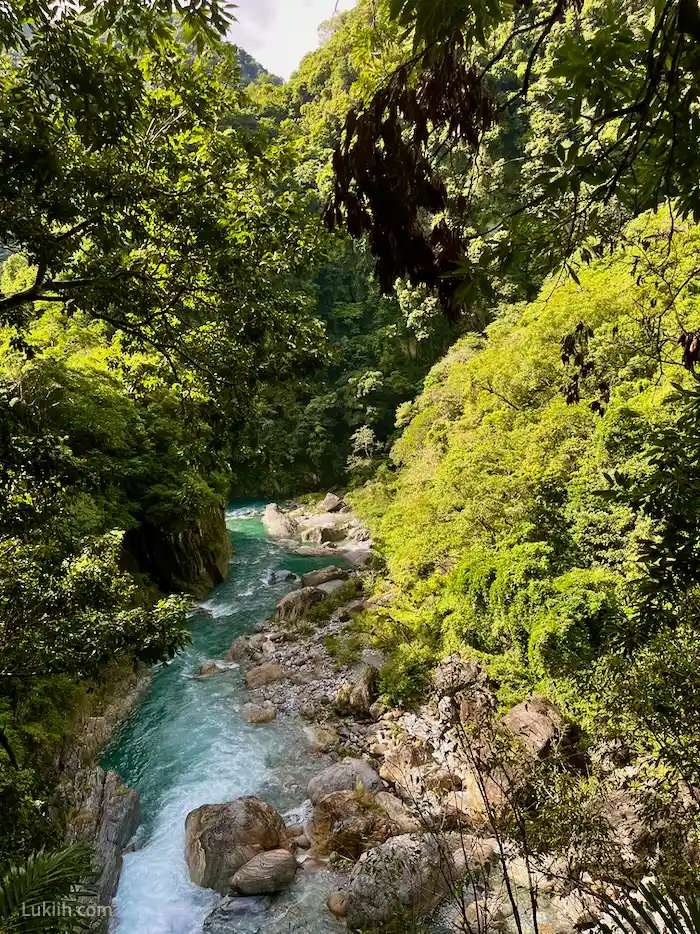
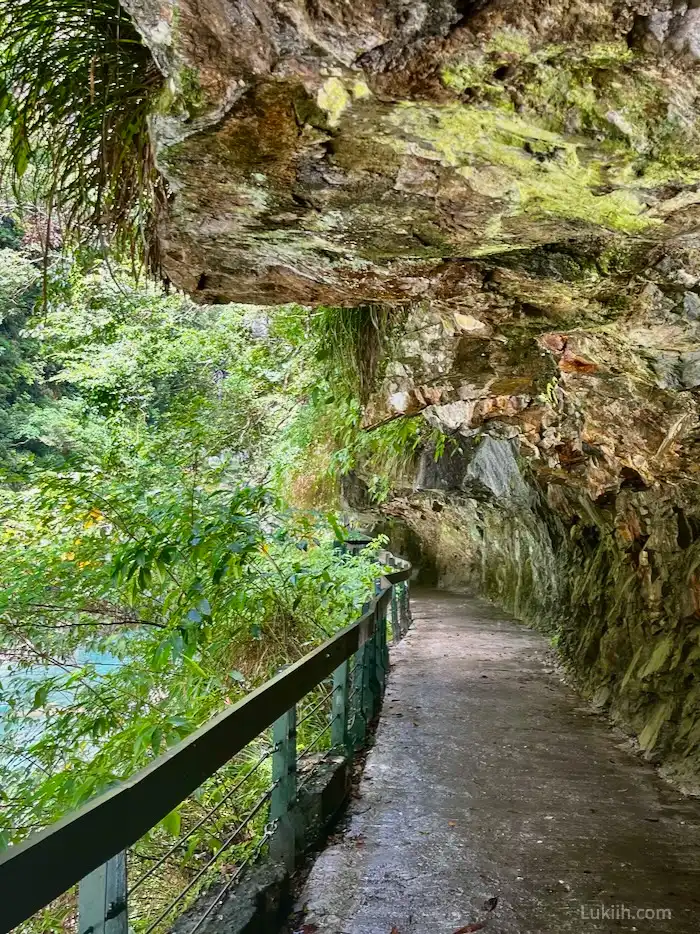
📍 Getting There: The Shakadang Trail starts here, near the entrance of the park.
⏰ Suggested Duration: 2 hours
Being one of the most popular attractions in Tarako Gorge and closest to the entrance, Shakadang Trail can get extremely crowded, so it’s best to go as early as possible and make it your first stop.
🏯 Eternal Spring Shrine
Eternal Spring Shrine, another popular stop, is a cluster of colorful shrines tucked into the mountain with a waterfall spewing out underneath. It was built to honor the 200+ workers who died while working on the highway in the early 1900s.
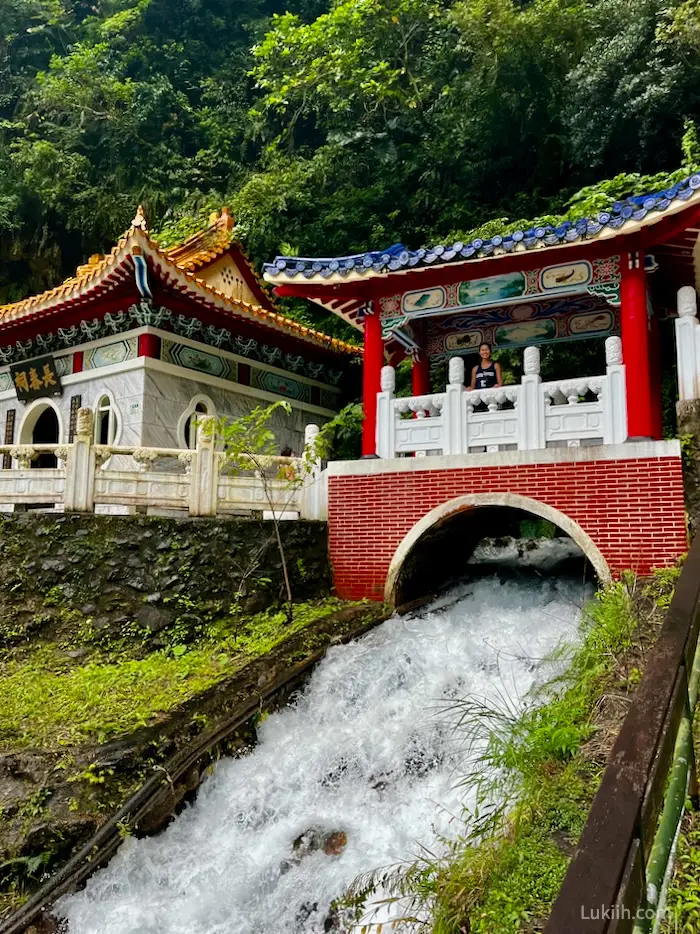
📍 Getting There: You can see the Eternal Spring Shrine from the parking lot here, where you can start the walk to the shrine after crossing a bridge and going into some tunnels.
⏰ Suggested Duration: 15-30 minutes
🏞 Buluowan Suspension Bridge
The Buluowan Suspension Bridge is one of Taiwan’s tallest bridges, and it leads to nowhere. It was built to give visitors a stunning panoramic view of the valley.
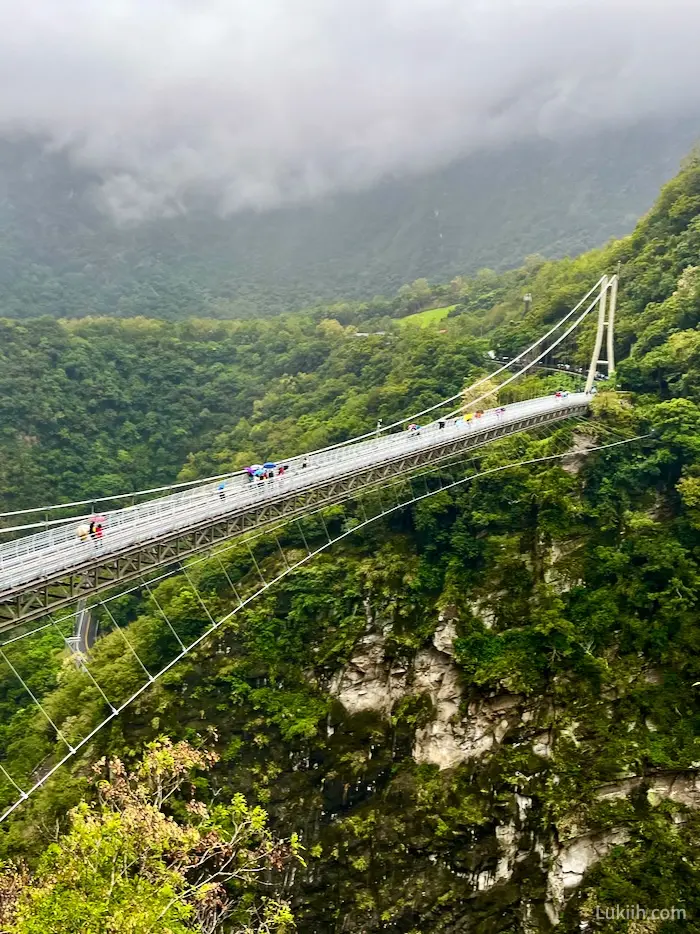
📍Getting There: To visit the Buluowan Suspension Bridge, you can park here and walk to the terrace before crossing the bridge.
⏰ Suggested Duration: 20-30 minutes
🌟 Other Attractions
If you can spend an entire day or more at Taroko Gorge, here are eight other great things you can see and do.
- Swallow Grotto – one of the narrowest parts of the gorge, with impressive sheer cliffs. While walking the short 0.7-mile-long Swallow Grotto Trail, you can see the steep marble cliffs with little holes, which are popular nesting spots for swallows.
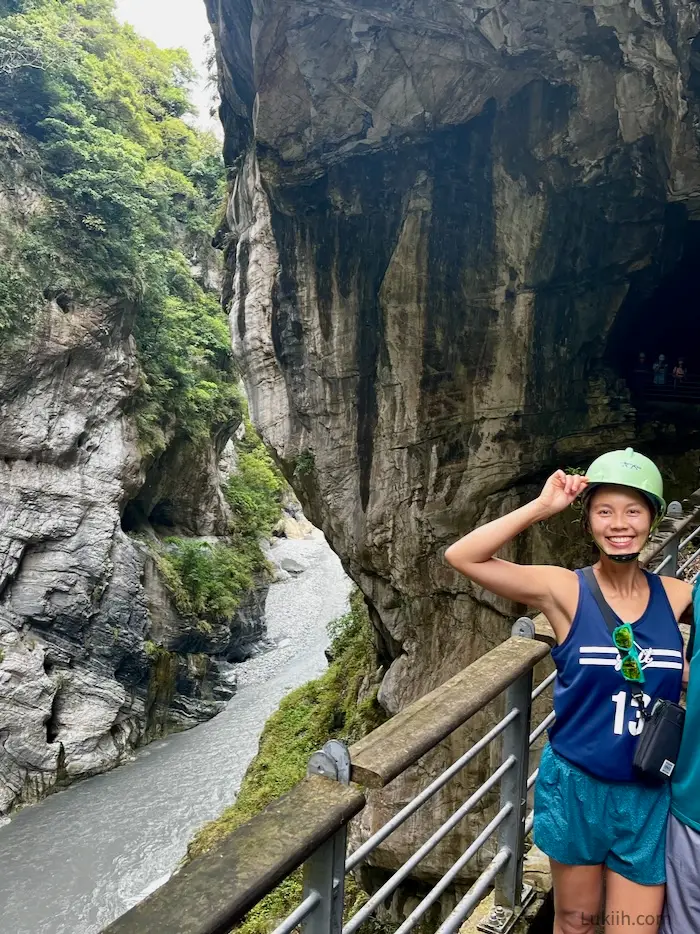
- Tarako Village Hotel – one of the few places where you can have a delicious aboriginal meal. My lunch was included as part of my tour package.
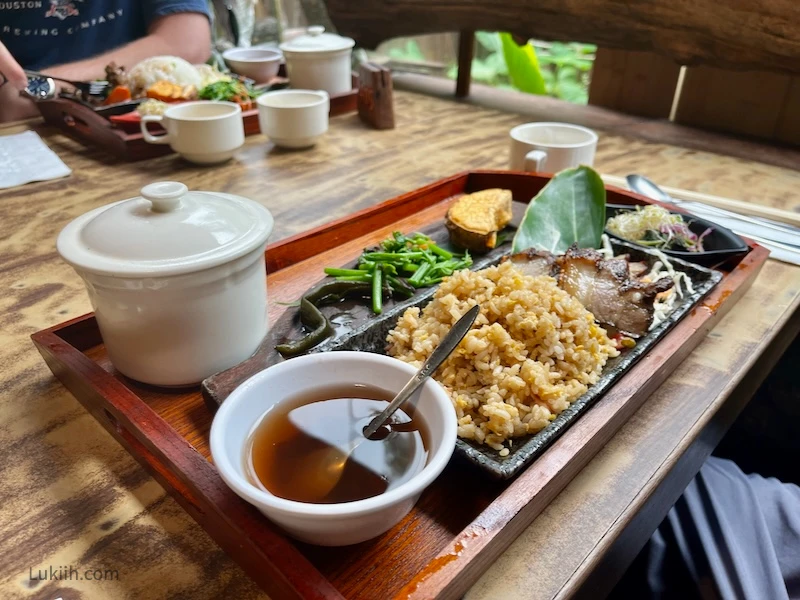
- Zhuilu Old Trail – a narrow trail with limited edge protection next to a 1,500+ feet cliff drop. It’s a challenging but adventurous hike that takes hours and requires a permit.
- Tunnel of Nine Turns – a well-maintained 30-minute walk featuring nine turns. It’s a fairly scenic route and showcases impressive engineering as the builders had to build through the gorge.
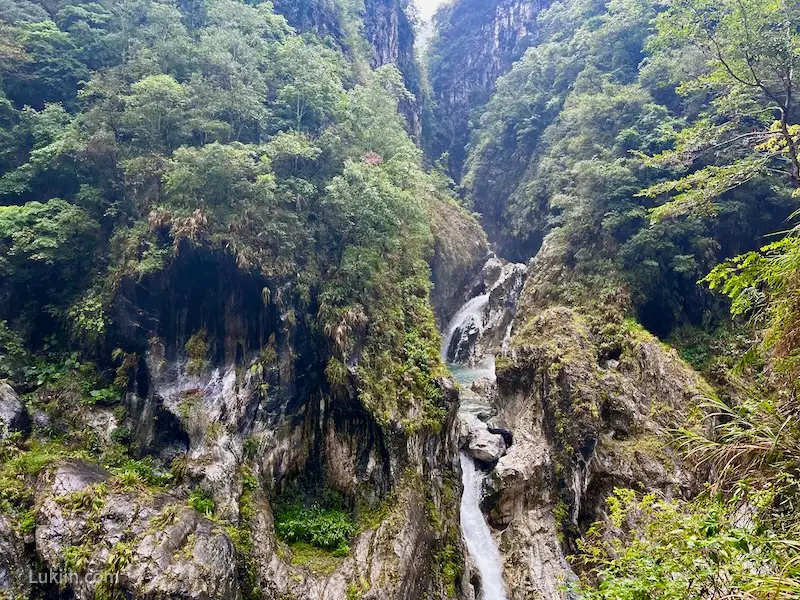
- Changuang Temple – a temple near the Eternal Spring Shrine that can barely be seen from the parking lot.
- Baiyang Trail – an easy hike that is less than an hour long and features a waterfall, cliffs, and tunnels. Bring a flashlight if you plan to visit it, as the tunnels have no lights.
- Qixingtan Beach – a good halfway stop between the national park and Hualien City. The beach is filled with gray and silver pebbles that contrast against a clear, blue ocean.
- Qingshui Cliffs – at 2,600 feet tall, it features some of Taiwan’s highest coastal cliffs.
Day Trip Itinerary
This Taroko Gorge itinerary efficiently sequences attractions and activities the park is famous for. I’ve included suggested times for each activity based on my experience.
The Taiwan trip planner below has this itinerary prefilled.
| Morning | ||
| 🚙 | Get to the Taroko National Park entrance and park | Before 9 am |
| 🍃 | Hike the Shakadang Trail | 9 am–11 am |
| 💧 | Visit the Eternal Spring Shrine1 | 11 am–11:25 am |
| 🐦 | Walk through Swallow Grotto | 11:40 am–12:10 pm |
| Afternoon | ||
| 🍚 | Have lunch at Taroko Village Hotel | 12:20 pm–1 pm |
| ⛅️ | Cross the Buluowan Suspension Bridge | 1:10 pm–1:35 pm |
| 🪨 | Walk through the Tunnel of Nine Turns2 | 1:50 pm–2:20 pm |
| 🚙 | Head to Hualien City and drive to Qixingtan Beach | 2:20 pm–3 pm |
| 🏖️ | Look out at Qixingtan Beach | 3 pm–3:20 pm |
| 🚙 | Return to Hualien City in time to take the train back to Taipei and arrive between 7–8pm3 | 3:30 pm |
If you have extra time or days in Taroko Gorge, consider making these modifications to the itinerary above:
- After visiting the Eternal Spring Shrine, head to the Changuang Temple. The two attractions share one parking lot.
- After visiting the Tunnel of Nine Turns, head west to hike the Baiyang Waterfall Trail.
- If you have a second day in Hualien City, I highly recommend visiting Hualien’s night market. If you like hiking, I recommend doing more hikes, including the Zhuilu Old Trail, which requires advanced preparation. If you’re not much of a hiker, check out the dramatic Qingshui Cliffs, located 20 minutes north.
What To Pack
Taroko Gorge has a subtropical climate, so you can expect a mix of humidity, rain, and sunshine when visiting. Here’s a complete packing list:
- Light rain jacket or poncho – It can rain all year around, with October being the wettest month and December the driest. I was glad I brought my rain jacket.

- Umbrella (optional) – Many visitors carry umbrellas. However, some areas, like the Buluowan Bridge, can get windy, so pack a windproof umbrella.
- Running shoes or hiking shoes – The paths are well-maintained, so you can visit most of the park with just a pair of running shoes.
- Water – Most attractions in the park do not have water readily available, so carry a reusable water bottle.
- Mosquito repellent – Taiwan has mosquitos that can spread dengue fever (you’ll see signs in Taipei encouraging you to protect yourself). I like to use this bug-repellent lotion.
- Sunscreen (optional) – Since you’ll be outdoors the entire day, make sure to wear water-resistant sunscreen.
- Flashlight (optional) – If you plan to visit Baiyang Trail, bringing a flashlight is recommended since the tunnels don’t have light.
- Snacks – The park doesn’t have food and snack stations readily available (and some of them run low on inventory), so bring some snacks.
Taiwan Trip Planner 2024
To make your travel planning easier, download the trip planner below and use it as a starting point. The planner has country-specific travel information, an itinerary, a packing list, and a map with key places pinned.
The trip planner is built on Notion, which I use for all my travel planning (I genuinely love this tool). If you don’t have Notion, creating an account is free.
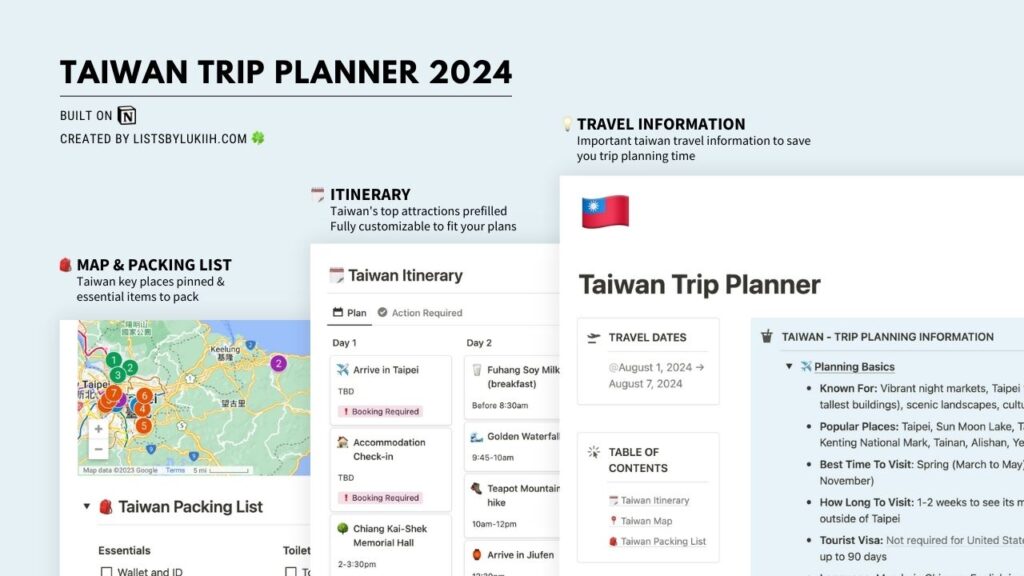
Thoughts? Questions? Leave a comment below.
🧋 Support Lukiih
Lists by Lukiih is a humble website that I fund with my own savings. If you find my tips helpful, I appreciate you saying thanks with a bubble tea!
